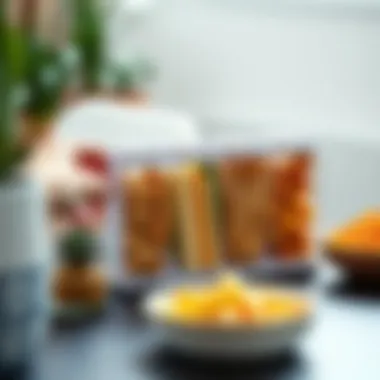Organizing Snacks: A Comprehensive Guide to Better Living


Intro
In today’s fast-paced world, snacking has become a beloved ritual for many. It’s more than just a hunger remedy; it’s a chance to unwind and indulge in whimsical flavors. Yet, the reality is that many find themselves grappling with snack clutter, leading to a chaotic environment that detracts from the enjoyment of this simple pleasure. This guide aims to explore the world of snack organizers—vital allies in transforming your snack routines from cumbersome to seamless.
From sleek countertop solutions to hidden drawer systems, a well-organized snack space can make a significant difference in your daily life. Let’s embark on this journey to explore the various methodologies for creating effective snack organizers that balance functionality with aesthetic appeal.
Design Trends
Current Trends in Furniture Styles
As we observe the flow of design trends, we've seen a rise in minimalist styles that focus on utility, marrying form with function. Open shelving units made of reclaimed wood are gaining traction, allowing you to display beautifully packaged snacks while keeping everything easily accessible.
Moreover, multifunctional furniture has become a headliner. Snack carts and mobile islands are not just practical; they bring an element of flexibility to any space. These pieces boast both storage and ease of movement, making them a favorite among homeowners keen on efficiency.
"The charm of organization lies in its ability to shift perception from mere functionality to a vibrant aesthetic experience."
How to Incorporate Trends into Your Space
Integrating current design trends into your snack organization can be likened to adding spices to a dish—too little may leave it bland, too much could overwhelm. Here are some thoughtful tips:
- Select a Color Palette: Choose a color scheme that harmonizes with your existing decor. Earthy tones blend well with rustic elements, while bright colors can uplift a modern kitchen.
- Use Natural Materials: Consider materials like bamboo or cork for their eco-friendly appeal. They not only add texture but also a warmth that can make a space feel inviting.
- Curate a Display: Arrange items aesthetically on your open shelves. Mix snack jars of different sizes with decorative items to create visual interest.
Buying Guides
Choosing the Right Furniture for Different Rooms
Selecting the appropriate furniture for snack organization isn't a one-size-fits-all scenario. Here’s how to tailor your choices:
- Kitchens: Focus on space-saving racks or pull-out drawers to maximize efficiency. Opt for transparent containers to easily spot favorite treats.
- Living Rooms: Snack trolleys that blend with your existing furniture can create a cozy atmosphere, allowing you to entertain with ease.
- Home Offices: Incorporate small bins or boxes that can be tucked away, ensuring that your work environment remains tidy while still accommodating quick snack breaks.
Tips for Assessing Quality and Value
- Material Durability: Inspect the craftsmanship and materials. Solid wood or sturdy metal options are more likely to stand the test of time.
- Functionality: Evaluate how easy the organizer is to use daily. Does it allow for efficient access to your snacks?
- Price versus Use: Sometimes a higher price tag reflects better quality. However, always consider how often you will use the organizer before making an investment.
By following these guidelines, you won’t just have an organized snack area but will also enhance the overall ambiance of your living space. Good organization doesn’t merely improve function; it elevates your experience.
For more information and resources, check out:
- Wikipedia on Home Organization
- Design trends insights on Britannica
- Join discussions on Reddit or Facebook Groups dedicated to home organization.
Prologue to Snack Organization
Snack organization might seem like a trivial concern in the grand scheme of things, but it holds a surprising significance in our everyday lives. Many folks often overlook how well-organized snack storage can elevate not just convenience but also the overall ambiance of a kitchen or living space. When we think of snacks, we conjure images of quick bites that often come in wrinkled bags and unkempt boxes scattered across countertops. But what if those moments could be transformed into something more harmonious and aesthetically pleasing?
One of the main benefits of proper snack organization is the ability to streamline access while minimizing clutter. If the chocolate bars and chips are neatly tucked away within dedicated containers, you’re less likely to feel chaotic when you’re hunting for that late-night munchie. A strategic setup can also foster mindful eating habits. According to various studies, when snacks are easy to reach, we might dip into them more frequently, be it as a thoughtful treat or mindless nibbling. Thus, curating your snack stash encourages more intentional choices—and it might even promote healthier options if organized thoughtfully.
Additionally, snack organization serves a deeper psychological purpose. A well-curated space provides a sense of control and order. Think of it as your personal zen zone; it encourages a calm mind, which is essential in today’s fast-paced life.
As we dive deeper into this guide, you will discover various types of snack organizers tailored to fit different homes and lifestyles, essential factors to consider when making your choice, and creative design ideas that can meld form with function seamlessly. By the time you’re done reading, you might find yourself viewing snack organization not merely as a chore but as an exciting project that brings a little more joy and flair into your everyday routine.
"Good organization, much like a balanced diet, is fundamental to a fulfilling life"
More than just an aesthetic choice, it becomes a catalyst for how we engage with food and our surroundings.
Prepare to explore beyond mere containers and labels; snack organization is about creating a space that reflects personal taste, embodies practicality, and sets a tone for a healthier relationship with what we eat.
Types of Snack Organizers
When it comes to snack organization, the nuances of different types of organizers can make a monumental difference. Each type serves its unique purpose, knowing the benefits and characteristics can enhance the overall efficiency of your snacking setup. Selecting the right type isn't just about aesthetics; it's about functionality and how well the organizer complements your lifestyle. The right choice can make a small kitchen feel spacious or tangled snacks a thing of the past.
Containers and Bins
Materials: Plastic, Glass, Metal


The choice of materials for snack containers and bins plays a crucial role in maintaining freshness and usability. Plastic is lightweight, typically more affordable, and can be molded into various shapes. It’s often the go-to for those who prefer practicality. However, it can absorb colors and odors from foods, so might not be the best choice for long-term storage.
Glass, on the other hand, boasts durability and a non-porous surface, making it an ideal option for keeping your snacks free from contamination. The transparency feature allows you to spot your favorite munchies at a glance, which can even add a touch of elegance to your kitchen. Yet, it can be heavy and breakable, requiring caution.
Metal containers tend to lead the pack when you're aiming for longevity, especially if you are looking for something sturdy. While they are great at protecting contents from moisture or pests, they might not be ideal for visibility. Plus, they can heat up quickly, which could be a concern for certain snacks, especially those sensitive to temperature.
Sizes and Shapes
Size and shape of snack organizers are paramount. A wide array exists—from tall and narrow containers to short and wide ones. Tall containers work great in limited space but can create challenges when accessing deeper snacks. Meanwhile, short, wide bins can allow for easy access but might require more surface area.
Various shapes such as rectangular or circular can cater to specific storage needs. Rectangular ones tend to fit better on shelves, whereas round bins might be better when stacking is needed. Consider also your type of snack; think about storing chips in a tight, tall bin to prevent them from becoming crushed.
Drawers and Shelves
Built-in Options
Built-in drawers offer a seamless, integrated look for any kitchen. Their interior can be customized to create zones for different types of snacks, keeping everything organized and accessible. This solution maximizes space more effectively than standalone units, making it ideal for smaller areas. The challenge with built-in options is upfront design and installation costs, which can be higher than acquiring freestanding units. However, they can significantly boost the value of your kitchen or living space over time.
Freestanding Units
Freestanding snack organizers provide versatility as they can be moved or re-arranged as needed. Often these come in a variety of styles, fetching designs, and can double as decorative elements in a room. They can be a compact option for anyone looking to maximize space without the constraints of permanent fixtures. However, freestanding units can take up floor space, so consider your room layout before deciding.
Wall-Mounted Solutions
Hanging Racks
Hanging racks offer an innovative way to utilize vertical space while keeping snacks visible and handy. This style adds character to your space and can serve as an eye-catching decorative feature. They can be particularly useful in kitchens where counter space is at a premium. The downside could be that they expose snacks to light and air, which might not be suitable for items needing protection from potent elements.
Magnetic Storage
Incorporating magnetic storage in your snacking routine provides a unique way to save space. These organizers can accommodate metal containers that adhere directly to a metal surface. Perfect for small herbs, spices, or even lightweight snacks, using magnets can enhance accessibility and visibility. However, this method may not work for all snacks, especially those heavy or bulkier items, and careful placement is essential to avoid spills.
Diving into the various types of snack organizers leads not just to a simpler way of snacking, but to a more elegant and enjoyable experience overall. Choosing wisely will lead to a harmonious arrangement of your snack essentials.
Factors to Consider When Choosing a Snack Organizer
Selecting the right snack organizer is not simply about aesthetics; it’s a decision driven by practicality and personal habits. Every individual has distinct needs based on their lifestyle and preferences. Understanding these factors can greatly enhance the effectiveness of any snack organization system. Let's dive into the main aspects to consider that can help customize your approach.
Space Availability
Kitchen Dimensions
When it comes to kitchen dimensions, the layout and size of your space drastically influence the type of snack organizer you'll choose. For instance, a compact kitchen may benefit from vertical storage solutions that utilize wall space, whereas a larger kitchen could accommodate expansive bins on a countertop. The key characteristic here is adaptability; organizers that can fit snugly into nooks and crannies without creating an eyesore are often a beneficial choice. A unique feature of well-designed kitchen organizers is their ability to blend in, ensuring that functionality doesn’t compromise the visual appeal of your culinary haven. An improperly sized organizer, however, can clutter or obstruct flow, detracting from the efficiency of the kitchen, which is something to keep a close eye on.
Living Area Considerations
Living area considerations extend beyond mere dimensions. You’ll need to assess how often snacks are accessed in those shared spaces, like a family room or an entertainment area, where the aesthetics play an important role. An attractive, well-placed snack organizer becomes part of the decor, enhancing the ambiance while offering easy access. This aspect makes stylish options such as decorative baskets or chic tiered trays popular choices. However, keep in mind the downsides of a beloved but impractical choice, as a too large or obtrusive unit can hinder movement and function in high-traffic areas.
Personal Consumption Habits
Frequency of Snacking
The frequency of snacking serves as a cornerstone in the decision-making process for choosing a suitable organizer. If you’re a frequent nibbler, you’ll want a setup that encourages easy access—perhaps a clear acrylic bin with compartments to separate your favorite snacks. In contrast, if you tend to snack less often, a simple drawer or shelf that keeps snacks out of sight may be a adequate choice. This consideration helps tailor the organization to your consumption habits, ensuring that whatever you choose fits seamlessly into your routine.
Types of Snacks
The types of snacks you indulge in greatly influence the organizing solution. For example, do you prefer healthy options like nuts and dried fruits, or are you more into chips and chocolates? Each category warrants different storage methods. Dry snacks might thrive in airtight containers, while soft snacks should be kept in a breathable space to avoid moisture buildup. This variability points out the importance of selecting organizers that cater to your snacking style—configurations that can handle a mix of snack textures while preserving their freshness will only enhance your overall experience.
Aesthetic Preferences
Modern vs. Traditional
Aesthetic preferences, especially regarding modern versus traditional designs, play a pivotal role in maintaining a harmonious space. Modern designs tend to embrace minimalism and clean lines, making it easy to streamline your snack organization. In contrast, traditional designs might encompass ornate or vintage-inspired containers that not only serve a purpose but also evoke nostalgia. The unique feature of choosing between styles is the emotional resonance. A well-chosen piece can create a welcoming atmosphere, though be careful; a mismatch could easily jar with existing decor, making the space feel chaotic.
Color Coordination


Color coordination is another layer of personalization that can elevate your snack organizing game. Harmonizing the colors of your organizers with the surrounding area can tie a room together beautifully. Opting for neutral containers can allow for flexibility when accessorizing; on the other hand, bright pops of color can inject energy and playfulness into a space. A distinct advantage of color coordination is that it helps in navigating your snack choices more easily, as visual cues can guide your decisions. Conversely, choosing clashing colors might lead to a disjointed look that distracts from the overall theme.
Designing Your Snack Organizer
Creating an effective snack organizer is more than just a chore; it's a chance to shape your environment into a more functional and pleasing space. A well-designed organizer is an extension of one’s lifestyle, streamlining access to beloved snacks while blending harmoniously with home aesthetics. By focusing on thoughtful layout, style, and customization, you can elevate the snacking experience.
Functional Layouts
Zones for Sweet and Savory
Organizing snacks into distinct zones, like sweet and savory, can have a significant influence not only on accessibility but also on the snacking experience itself. This approach allows for the quick selection of desired items without the hassle of rummaging through other snacks. The key characteristic of establishing these zones lies in instinctual browsing; for instance, if one's craving chocolate, knowing that sweet snacks are clearly defined on one shelf cuts down on decision fatigue. Moreover, the unique feature of such separation helps in keeping a balance, potentially encouraging healthier choices by visually distinguishing what could be considered a treat versus what might be daily fuel.
This method serves as a beneficial practice in preventing kids or adults alike from mindlessly mixing together snack heftily, which can lead to overeating or confusion at snack time. Avoiding chaos in selecting snacks leads to less waste too, making it an efficient strategy for households prone to snack expiration.
Accessibility Considerations
When designing your snack organizer, accessibility mustn't be an afterthought. It's about being able to reach for what you need without bending, stretching, or even outright forgetting about snacks tucked away. The vital aspect here is the placement of items, primarily focusing on height and frequency of use. Snacks you reach for frequently ought to be front and center, while special occasion treats can be stored higher or in out-of-the-way spaces.
Also, you’d want to think about the type of containers used. Transparent bins serve as excellent visual cues, making it easy to spot favorite snacks at a glance. But remember, with this convenience comes a trade-off; sometimes visual clutter can feel overwhelming if not managed correctly. Finding that sweet spot between visibility and organization is crucial to ensuring snacks are both accessible and neatly arranged.
Incorporating Style
Use of Decor Elements
Consider the aesthetic appeal of your snack organizer; it shouldn't just be functional but also convey a certain style that reflects your taste. By incorporating decor elements, such as a trendy bowl for fruits or a rustic box for granola bars, you're able to seamlessly blend the organizer into the home’s overall theme. Decorative containers can act as focal points in your kitchen or dining area, transforming a simple storage necessity into a centerpiece.
The unique feature of integrating decor lies in its ability to enhance visual interest and create a more inviting atmosphere for guests and family alike. While this can effectively upgrade your space, striking a balance between style andfunctionality is crucial, as overly ornate designs can detract from purpose.
Mixing Materials
Mixing materials is another fantastic way to design your snack organizer with both functionality and style in mind. Combining different textures like wood, metal, and fabric can introduce warmth and creativity to the space while offering practical advantages. A wooden snack bin paired with metal containers can provide contrast and grab attention.
This strategy encourages versatility in usage. Containers can be selected for their specific functions—such as lightweight bins for easy lifting or sturdy containers for bulk items. However, careful consideration is needed, as not all materials mix well. A lack of cohesion over time can lead to an unsightly and cluttered appearance.
Custom vs. Pre-Made Options
Benefits of Customization
Customization offers extensive flexibility when it comes to designing the perfect snack organizer. Tailoring your organizer allows you to align it with your specific preferences, including colors, dimensions, and features that cater to your unique snacking habits. This means you can perfect both the aesthetic and functional aspects, whether you're dedicated to portion control or require different compartments for various snack types.
However, one must keep in mind that customization demands a higher investment of both time and resources. It often takes longer than simply picking out a pre-made option, and the cost could be significantly higher depending on the materials and craftsmanship.
Evaluating Pre-Made Solutions
On the flip side, evaluating pre-made options can save considerable time and effort. The market is full of appealing pre-made snack organizers that can fit almost any kitchen style you may have. Hence, it’s important to assess their functionality and aesthetics based on your specific needs.
Pre-made options can be a great solution if you're someone who seeks immediate organization without the wait for custom builds. Nonetheless, one might encounter limitations regarding sizing and compartmentalization. Not every product perfectly matches every individual’s requirements, and making occasional compromises may be necessary.
Astutely weighing the pros and cons can guide you to make an informed choice.
Maintenance and Care
Keeping snack organizers tidy and functional is crucial, as it directly affects not just the appearance of your storage solutions but also the quality of your snacks. Well-maintained organizers can prevent spoilage, allow for ease of use, and ensure that you or your family can grab a quick bite without stumbling over an avalanche of chips or sweets. A little regular upkeep goes a long way in promoting a pleasant snacking experience.
Cleaning Strategies
Best Practices for Different Materials
Understanding how to clean various materials effectively is essential. Plastic, glass, or even metal organizers each have their quirks. Plastic containers are lightweight and often hold up well against impact, but they can get scratches that trap dirt. The best approach here is to use gentle soap and a soft sponge. Avoiding abrasive materials is also a good rule of thumb.
- Glass containers, while more aesthetically pleasing, can be heavy and prone to shattering. A simple wipe-down with warm soapy water ensures they stay pristine. They typically don’t hold onto odors, but it’s wise to rinse thoroughly after cleaning to prevent any soap residue.
- Lastly, for metal organizers, a damp cloth usually does the job unless there’s significant grime. They’re durable but can rust if not dried properly after washing. Keeping them dry is just common sense. Each material serves its purpose, so picking the right one for your snacks means thinking about not just style but also upkeep.
Frequency of Cleaning
How often cleaning needs to be done can vary based on your snacking habits. For example, if you’re an everyday muncher, consider a quick clean-up once a week. This keeps crumbs and remnants from accumulating, which can attract pests or lead to unpleasant odors.


- A monthly deep clean is another smart strategy, especially if it's been a wild month with holiday parties or gatherings.
- Simply put, maintaining freshness helps prolong the life of your snacks and keeps you breezy during snack times.
Managing Expiration Dates
Keeping track of what’s in your snack organizer goes a long way in ensuring you don’t end up with stale snacks.
Tracking Snacks
Implementing a system to track your snacks is fundamental. This can involve simply noting expiration dates on a calendar or using a digital app to remind you when something’s about to go bad.
- One excellent method is to arrange snacks with the soonest expiration dates in front, making it easy to grab and use. The idea here is to keep everything in sight.
- This transparency in your snack drawer keeps things fresh and minimizes waste.
Healthy Disposal Methods
Once snacks have met their expiry dates, it’s key to handle disposal with care, especially with items that can create messes like chips or candies.
- Opt for biodegradable bags to toss stale snacks, which decreases landfill waste. If it’s packaging that can be recycled, make sure to rinse it out before tossing it in the recycle bin.
- Another smart trick is to use a compost bin for any organic snacks or perishable items. This way, you’re not just throwing things away; you’re contributing to a healthier world.
It's clear maintenance and organization are indispensable in creating a stress-free snacking experience. Keeping things clean, fresh, and monitored elevates less-than-exciting snacks into delightful go-to treats.
Inspiration for Snack Organization
Snack organization may seem like a trivial matter at first glance, but its importance can’t be overstated. The way we arrange our snacks greatly influences our consumption habits, fostering not just convenience but also creativity. A well-organized space can elevate the entire snacking experience, transforming routine munching into a delightful exploration of flavors. Moreover, engaging in the process of organizing snacks can be a form of self-expression, allowing individuals to reflect their personality and lifestyle choices in how they manage their treats.
Why seek inspiration? Well, for starters, moving beyond generic solutions paves the way for more tailored approaches that resonate with personal needs and tastes. This section delves into some creative avenues and trends that can breathe new life into one’s snack organization game.
Creative DIY Solutions
Repurposing Household Items
Repurposing household items is a gem within the realm of snack organization. This approach is not only eco-friendly but also budget-friendly, utilizing things that might otherwise gather dust. Think about using an old shoe box to store packets of chips or a decorative jar for nuts and dried fruit. The key characteristic of repurposing is its ability to seamlessly blend functionality with personal flair, creating an organizer that tells a story while serving its purpose.
The benefit here is twofold: first, it reduces waste, giving old items a new lease on life; second, it allows for a unique touch in organizing snacks that commercially bought organizers may lack. However, one must consider the unique idiosyncrasies of these items, such as cleanliness and aesthetic coherence, which may require additional effort to maintain.
Crafting Unique Containers
Moving into the sphere of crafty projects, styling unique containers can add a layer of charm to snack organization. Whether it’s turning glass jars painted with vibrant hues or constructing a tiered stand from repurposed wood, the creativity in crafting is boundless. The key characteristic here is personalization; these containers can reflect one’s individual taste and style, making the snack area not just organized but also visually appealing.
The advantage of crafting unique containers lies in their customizability. You can tailor every aspect to fit perfectly within your home decor while ensuring optimal use of space. Still, crafting involves a time commitment, and there's a chance of missteps during the process. Thus, individuals should weigh their interest and skills in DIY against their actual needs when venturing into this decorative realm.
Trends in Snack Organization
Minimalism in Design
Minimalism in design has gained traction, and for good reason. It speaks to the idea of 'less is more.' In terms of snack organization, this trend emphasizes clean lines and functionality without unnecessary visual clutter. The popularity of minimalism stems from its ability to create a calming, organized environment, which can further reduce the chaos often associated with snack time.
With sleek containers and streamlined designs, minimalism can enhance the overall aesthetic of a kitchen or living area. However, one needs to balance function with aesthetics, as sometimes minimal designs may sacrifice practicality for appearance.
Sustainable Options
Lastly, sustainability has become more than just a trend; it is a way of life for many. Choosing sustainable snack organization solutions means selecting materials that are eco-friendly, such as bamboo or recycled plastic. The core characteristic of sustainable options is their long-term positive impact on the environment, which many enthusiastic consumers value.
These sustainable choices resonate well with a growing concern regarding waste. They can serve as conversation starters, reflecting one’s commitment to mindful consumption. Nevertheless, one must also take into account the potential cost implications, as sustainable options can sometimes carry a higher price tag than conventional products.
"Creating a snack organization system that encompasses both creative flair and practicality can truly transform how we relate to our snacks."
End
As we wrap up this guide, it becomes clear that thoughtfully organizing snacks is more than just a storage solution; it significantly influences our day-to-day interactions with food, our consumption patterns, and even the aesthetics of our living spaces. Snack organization is not merely about keeping things tidy, but also about creating an environment that promotes mindful eating and enhances the overall snacking experience.
One of the key elements we've touched upon is how effective organization can lead to reduced stress and enhance productivity. Imagine standing in front of a chaotic pantry where snacks appear to be out of control—it's overwhelmingly uninviting. In contrast, a well-organized snack storage solution not only catches the eye but also encourages better food choices. With snacks clearly laid out and categorized, the likelihood of impulsive and unhealthy eating diminishes.
Benefits extend beyond visual appeal and accessibility. A well-crafted snack organization system can help individuals monitor their consumption patterns. By making snacks visible, it becomes easier to track what you eat and adjust accordingly. This little adjustment can foster healthier habits without overwhelming you with strict dietary rules.
When considering the elements at play, we should reflect on individual lifestyles and the varied purposes of different organizing solutions. For instance, DIY enthusiasts might find joy in creating their own solutions, while busy professionals might prefer pre-made organizers that fit seamlessly into their life. This adaptability is crucial, as the same organizational principle can serve multiple households with different needs.
Thus, evaluating both personal habits and aesthetic choices enhances the effectiveness of any snack organizer. The incorporation of features that align with one's lifestyle not only sustains the organization but also elevates the overall living experience. The takeaway here is that snack organization is not merely a trend; it is a lifestyle choice that artfully marries function with flair.
Properly organizing snacks can transform not just your diet, but your entire kitchen environment.
In closing, embracing the art of snack organization is a multifaceted endeavor. It offers benefits that reach far beyond simple tidiness. With a keen eye for design and an understanding of personal needs, your snacking setup can become a vital part of your home, creating a welcoming space that supports health and happiness.















